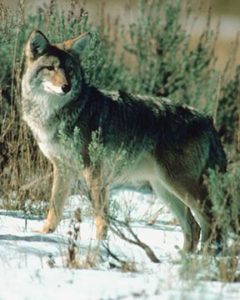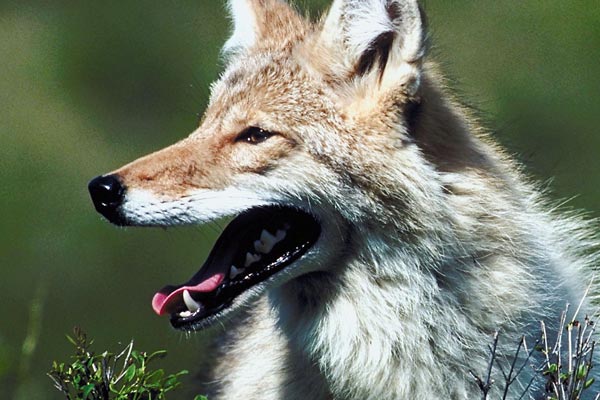(Excerpts below are from an article on coyotes entitled, “Elusive Creature Returns” which was authored by Retzer volunteer naturalist Maureen Patton-Gross and first appeared 30 years ago in the Jan/Feb 1987 “Center Line” issue. In the article, she clearly distinguished coyotes from other canids based on their size, color, tail, voice, tracks, and scat.)
 “There is an elusive creature living here who is a master at escaping human detection. On moonlit nights his shadow slips silently across the snowy southeastern Wisconsin landscape unnoticed. His nocturnal call is sometimes heard as a distant, mournful requiem causing friends to huddle closer to the campfire. His larger relative – a resident of the Great North Woods – is the majestic timber wolf. In scientific jargon he is known as Canis latrans but in the vernacular he is known as the coyote.
“There is an elusive creature living here who is a master at escaping human detection. On moonlit nights his shadow slips silently across the snowy southeastern Wisconsin landscape unnoticed. His nocturnal call is sometimes heard as a distant, mournful requiem causing friends to huddle closer to the campfire. His larger relative – a resident of the Great North Woods – is the majestic timber wolf. In scientific jargon he is known as Canis latrans but in the vernacular he is known as the coyote.
Though seldom seen, especially during daylight hours, the following description will help identify this animal. The typical adult coyote ranges in weight from 20-35 lbs. The average height at the shoulders is about 20 inches. The ears are prominent, erect, pointed, and reddish in color. The muzzle is long, narrow and snuff brown to cinnamon brown in color. The forehead and cheeks are paler, mixed with gray and black. The upper parts of the body from the neck to the tail are coarsely mixed with gray and black, with a general tone of gray to cinnamon gray. There is a blackish line down the back. Underparts are buffish.
Often observations of coyotes are brief and the animal can be confused with other canids. However, there are ways to recognize the differences by general size and the tail… A coyote is somewhat larger than a red fox and does not sport a large white tip on the end of the tail. Often the coyote tail has a black tip. Although the gray fox has a black tail tip, it has a noticeable black stripe all the way down the top side of the tail and is considerably smaller than a coyote. Also, red foxes and gray foxes carry their tails straight out while running, as do wolves. The coyote frequently holds its tail down low while running. Because of the great variation in size and color of the domestic dog, it can easily be confused with the coyote. A dog, however, tends to carry its tail curled upward and its tail is much narrower than the bushy tail of a coyote.
Though normally silent, the coyote occasionally communicates audibly. His voice is higher pitched than wolves and many dogs. The characteristic coyote call consists of a vibrant yapping howl that leads into a long, broken, shrill scream. The complete repertoire of coyote vocalization is varied and complex.
Since direct observations of the coyote are infrequent, the best way to detect the presence of a coyote is through certain clues of what might be coyote signs. Coyote tracks are the most common sign found. Typical of canids, the front footprints are larger than the hindprints… Red fox tracks are generally somewhat smaller and, under good tracking conditions, have a ridge impression in the heel of the print. Gray fox tracks are smaller yet and resemble large house cat tracks with claw impressions.
Although some dogs leave prints within the size range of the coyote print, coyote tracks are longer and narrower. For example, a coyote track would typically measure 2 ½ inches long by 1 ¾ inches wide, while a dog track of similar size commonly measures 2 ½ inches by 2 ½ inches. Often the heel pad of a dog is larger and more pronounced.
Scat (droppings) is another kind of wildlife sign that biologists use to confirm an animal’s presence. Coyote scat can be confused with that of a dog. Coyote scat is generally about 4 inches long but size may vary. Dog scat is recognized by the content of dog food, whereas coyote scat often contains fur and bone. At times coyote scat is very dark indicating red meat has been eaten. It may also contain vegetable matter or even insects.”


